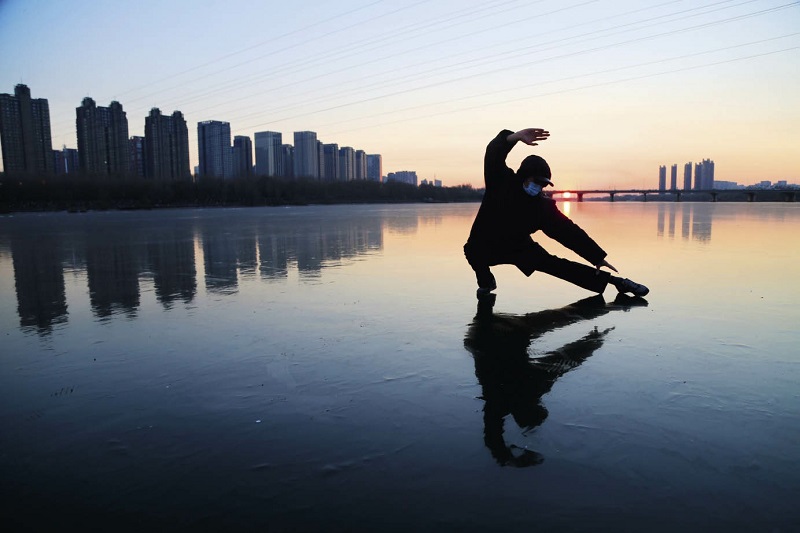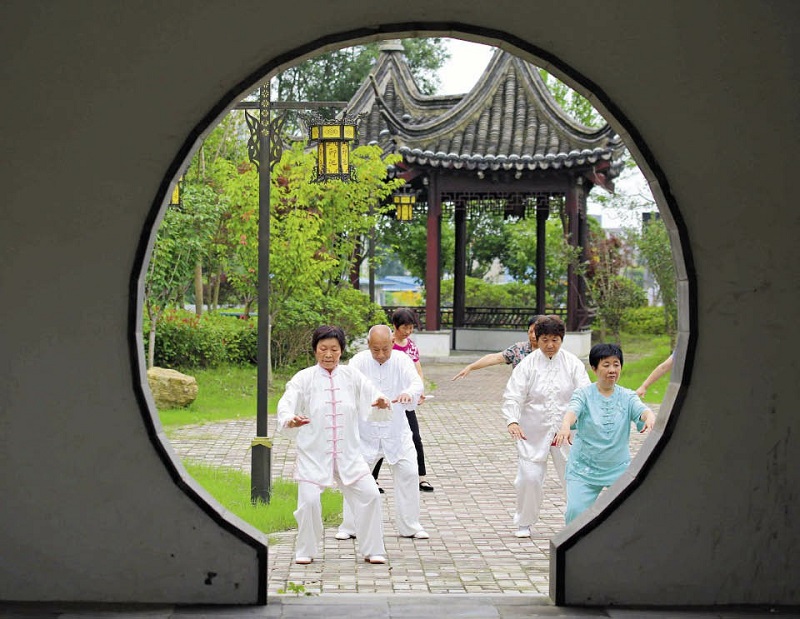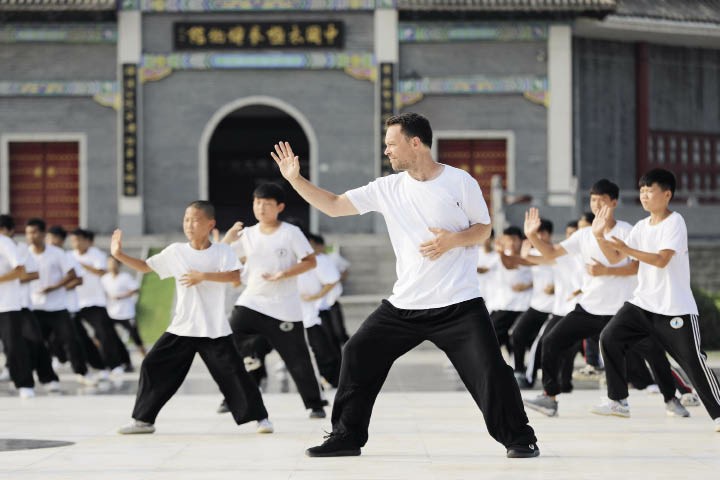On December 17, 2020, Taijiquan (also known as tai chi) was inscribed on the UNESCO’s Representative List of the Intangible Cultural Heritage of Humanity. The traditional physical practice, which originated in China, is “characterized by relaxed, circular movements that work in concert with breath regulation, and the cultivation of a righteous and neutral mind” according to a description from the UNESCO website. It is an expression of China’s unique traditional culture and not only improves physical fitness, but also cultivates the mind.
Taijiquan, as a traditional physical practice, originated during the mid-17th century in Wenxian County, Henan Province of central China, but it is now practiced throughout the country by people of all ages and by different ethnic groups. Taijiquan’s basic movements center upon five steps called wubu and eight techniques called bafa with a series of routines, exercises, and hand-pushing skills known as tuishou. Influenced by Daoist and Confucian thought and theories of traditional Chinese medicine, the element has developed into several schools (or styles) named after a clan or the name of a master. The element is passed down through clan-based transmission or the master-apprentice model. The latter relationship is established through traditional ceremonies. Taijiquan has also been incorporated into the formal education system. The element builds upon the yin and yang cycle and the cultural understanding of the unity of heaven and humanity. It has been disseminated through legends, proverbs, and rituals, among other vehicles of expression. Safeguarding the element would increase its visibility and dialogue about the diverse ways Taijiquan is practiced by different communities.

A local citizen of Shenyang, northeast China’s Liaoning Province, practices Taijiquan on the frozen Hunhe River on December 4, 2020.
Origins
In the mid-17th century, Chen Wangting, a native of Chenjiagou, in Wenxian County, Henan Province, created Taijiquan by combining martial arts, which his own family practiced, and the ideas behind the I Ching (also known as the Book of Changes) along with traditional Chinese medicine.
Taijiquan has been passed down from one generation to the next in Chenjiagou and has inspired various schools, such as the Yang, Chen, He, Wu, and Sun styles. Each of them has their own history, but at the same time, they all have taken certain elements from other schools of practice which have allowed various styles to flourish in their own way. There are currently more than 80 forms of martial arts and weapon routines and more than 20 tuishou.
In its early days, the Chen style was mostly based on the ideas of attack and defence. Later, at the end of the Qing Dynasty (1644-1911) and the beginning of the Republic of China (1912-1949), as the cold weapons era came to an end and Western concepts around the practice of sports were introduced, the quest to “strengthen the body” became more important and keeping fit is now the main objective for people who practice this discipline.
After the founding of the People’s Republic of China in 1949, Chairman Mao Zedong called on the whole country to practice Taijiquan, which was adapted by the National Sports Commission (now the General Administration of Sports of China) and incorporated into sports competitions.
In order to make the practice of Taijiquan easier to learn by the general public, in 1956 the National Sports Commission began to simplify the routines by eliminating complicated and repetitive movements. The Commission organized experts to compile the competition routines of four styles of Taijiquan, which have been promoted to different degrees over time.

Local senior citizens practice the basic moves of Taijiquan in Baipu Town of Rugao City, Jiangsu Province in east China on July 26, 2020.
Physical Benefits
As a form of aerobic exercise, Taijiquan is not only based on the movement of muscles and bones, but also promotes blood circulation, which in turn helps strengthen the body and prolong life.
This practice also involves deep abdominal breathing, which can have a positive impact on internal organs and help people to relax their whole body. As such, it can decrease vascular resistance, accelerate blood circulation, and reduce heart pressure, all of which is also beneficial in the treatment of cardiovascular problems, heart disease, and other ailments. In addition, it stimulates metabolism, increases the elasticity of joints and bones, slows down aging, and helps with weight loss.
In recent years, Taijiquan has been widely taught and practiced in universities, high schools, and elementary schools, and has even been made a mandatory course by some schools. This is proof that the discipline is not only intended for the elderly in the park, but also an effective way for young people to keep fit.
After the outbreak of the COVID-19 pandemic, makeshift hospitals were built in the Chinese city of Wuhan. During their spare time, medical staff led patients in appropriate exercises, including the practice of Taijiquan.
At Dahuashan Hospital, for example, patients were instructed to practice Taijiquan and do other forms of exercise to enhance their health as part of their medical treatment, which not only helped boost their spirit, but also improved their immune system.
Courtesy, modesty, the circulation of yin and yang (counterbalancing opposing forces), and harmony between humans and nature are all principles deeply engrained in Taijiquan, which in turn help cultivate people’s character and broaden their wisdom, bringing immense benefits. There are currently more than 50 million people who practice it nationwide.

Englishman Joseph Dauey performs Taijiquan together with other Taijiquan lovers on August 8, 2020 in front of the ancestral shrine of the Chen style Taijiquan in Chenjiagou, Wenxian County, Henan Province.
The Practice of Taijiquan
There are no restrictions related to age, physique, occupation or ethnicity when it comes to practicing Taijiquan. More than that, it can be practiced at any time and in any place. However, Taijiquan exercise is very different from most modern Western sports.
“In order to learn Taijiquan, it is necessary to establish a good foundation and learn the basic movements,” recommended Chen Zhenglei, representative of the 11th generation of Chen-style Taijiquan. “Beginners may not understand why these movements are so important, but as they continue practicing and the teacher helps them adopt the correct posture, they will feel their powerful effects,” he added.
For Chen Zhenglei, Taijiquan also requires mastering the body’s balance, relaxing it, and properly applying strength. In addition, diligence and perseverance are also very important.
Zhang Jinxi, Chen Zhenglei’s student, believes that having a good master is essential in the practice of Taijiquan. If a person only resorts to good posture but doesn’t have the guidance of a teacher, it will not be possible to understand its secrets. For this reason, said Yan Shuangjun, a former deputy director of the leading group for the application of Taijiquan for the entry into the UNESCO’s Representative List of the Intangible Cultural Heritage of Humanity, Wenxian County has been building a professional undergraduate school and a university specializing in Taijiquan, aimed at nurturing top-quality trainers and talents.
Taijiquan has now spread to more than 150 countries and regions, of which more than 80 have established Taijiquan organizations, with 400 million practitioners. After its inclusion in the UNESCO’s list, there will no doubt be many more followers in the times to come.